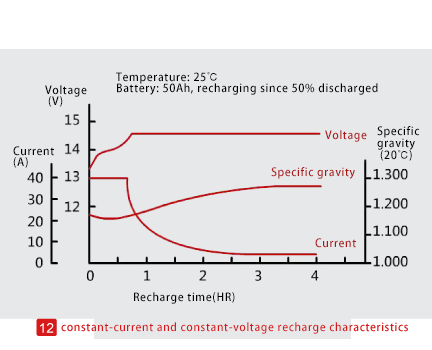The discharged battery should be recharged as soon as possible (Discharged battery may be crashed if stored for a long time). There has variety of charging methods to battery usage, which has different recharge characteristics。
● Constant-current recharge characteristics
Constant-current recharge is the way that charge at rated current from the start to the end. 5 hour-rate and 1/10 ratio current recharge is the general standard.
Specific gravity of electrolyte is hardly increasing during initial phase of charging, but when voltage reached 14.1~14.4V (2.35~2.4V/Cell), specific gravity would
rapidly increase because of electrolysis that cause gas emitting. Finally, specific gravity would stop increasing when reached the final phase of charging. Voltage
gradually rises due to sulfuric acid diffusion. At the final phase, lead(II) sulfate has reduced, which cause water electrolysis that emits oxygen and hydrogen
ast. Furthermore, charging voltage is also affected by current and temperature.
10
● Constant-voltage recharge characteristics
Constant-voltage (2.3~2.5V/cell) recharge method is charging current counts on voltage. The more difference of electric potential, the more current will supply.
This method has advantages of no gas emits and efficient. Due to initial charging current is high that needs a charger with much more capacity, constant-current
and constant-voltage recharge method is better way for charging.
● Quasi-constant-voltage recharge characteristics
It is a transformation of constant-voltage recharge whose voltage and current are both changed during charging. Initial phase has high current when battery’s
voltage is low, final phase has low current when voltage goes up. It is widely adopted to common battery rechargers.
11
● Constant-current and constant-voltage recharge characteristics
Restrict maximum charging current and voltage. Initial charge phase uses constant-current, and then uses constant-voltage which is faster and more
efficient. This method has been adopted to automobile charging system。
12


● Other recharge methods
1.Float and trickle charging
The method of sustain charging status of the battery.
a.The battery and the load are always in connection
(Float charging)
When DC power is supplying electricity to the load, it is supplying trickle current to the battery at the same time because of self-discharge. If the loading comes
more or suddenly blackout occurs, the battery will supply electricity to the load。
13
3
b.The battery and the load are separated that usually used in common
(Trickle charging)
DC power usually supplies trickle current to the battery in the use of engine start. When engine starts, the battery will supply electricity to engine. (This recharge method which just fulfilled self-discharged is called maintain charging, too.)
Float charging depends on specific gravity of electrolyte in 3. Charging current (which is 1/500~1/2000 of 5HR in common) depends on battery is new or old, and temperature.
Moreover, please use float charge type battery.
2.Equalizing Charge
When the battery is in float charge situation for a period, some cells' voltage might become lower. Equalizing charge can brings all cells to similar levels by increasing the
voltage, which should be done every 3~6 months. When taking constant-voltage method in equalizing charge, recharge for 8 hours at 14.4V (2.4V/cell) in general if
specific gravity is 1.280, and battery is 12V。
Besides, when recharging at 5HR with constant-current method, keep charging until full-charged for 4 hours. If battery is used for float charge, please refill the water
before equalizing charge。 (Do not refill the water during float charge. If it is necessary, stop charging, refill the water, and then apply equalizing charge.)






















